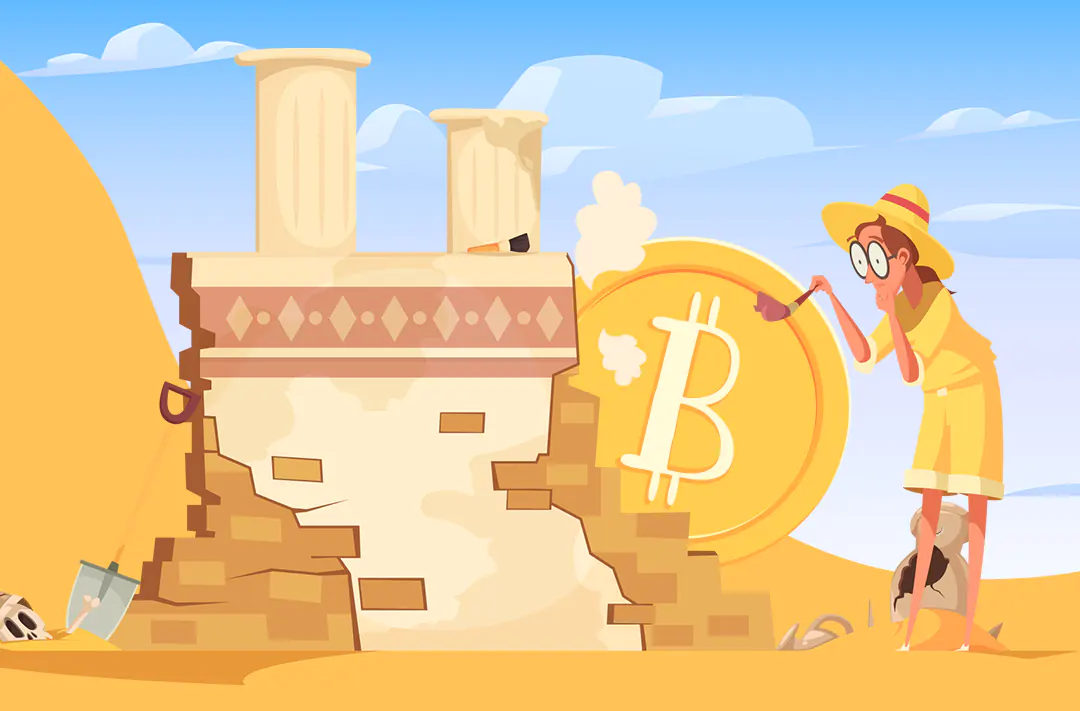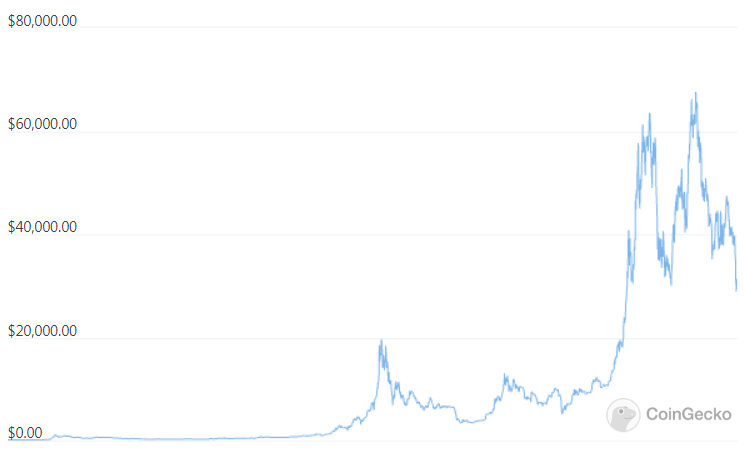How bitcoin emerged. A brief history of the first cryptocurrency
Let's describe the journey bitcoin has taken over the past 13 years and how it has grown to become a more than $1,2 trillion asset at its peak value in late 2021

17.05.2022
783
9 min
0
Bitcoin is considered the first cryptocurrency, but its emergence was preceded by decades of development in areas such as distributed ledgers and cryptography. Here's a brief history of how the first decentralized payment system came about.
Blockchain and the idea of cryptographic encryption
Cryptographers have been discussing the potential of an encrypted distributed ledger since the early 1980s. However, the first developments in this direction appeared only in the next decade.
American cryptographers David Chaum and Stefan Brands were the first to develop the principles of an anonymous digital payment system. In 1990 they created the eCash project, which maintained the confidentiality of electronic payments and provided cryptographic data protection. Its fundamental difference from today's cryptocurrencies was centralized management, which made the system vulnerable.
In 1998, cryptographer and businessman Adam Buck developed the Hashcash technology, a proof-of-work system for information networks that is resistant to hacker attacks and spam. This principle was used in the bitcoin blockchain and other cryptocurrencies. Based on Hashcash, other systems were created that used a distributed ledger. Independently of each other, developers Wei Dai and Nick Szabo launched the B-money and Bit-Gold projects. These systems became real cryptocurrency prototypes.
The first blockchain was created by American programmer Hal Finney in 1998. Later his developments would be used to create BTC, and Finney himself would become the world's first bitcoin recipient.
The emergence of the bitcoin
In 2008, an unknown person (or group of persons) under the pseudonym Satoshi Nakamoto published a White Paper in which they described in detail a decentralized payment system based on a distributed ledger. The text contained information about the key features and benefits of blockchain and bitcoin.
White Paper is a document describing the concept of the project and its roadmap.
Bitcoin (BTC) is digital money, which, unlike conventional fiat currencies, is not controlled by banks or the government. Bitcoin's stability is ensured by thousands of computing devices distributed all over the globe. Anyone can become a blockchain participant by installing the appropriate software. The distributed ledger is based on open source code that anyone can study.
Bitcoin was the first cryptocurrency and is still the leader in terms of capitalization. Users can send and receive payments in BTC as well as use cryptocurrency as an investment tool. This currency cannot be censored, for example, by blocking the wallet, stopping or canceling a transaction.
In 2009, the first 50 bitcoins were released after the genesis block was generated. The developers launched a test transaction: Satoshi Nakamoto sent 100 coins to another participant of the blockchain network. The first version of Bitcoin 0,1 software worked only on Windows 2000, NT, and XP. In the fall of 2009, Bitcoin was bought for the first time with fiat currency. The transaction amounted to $5,02, 5050 BTC at the time.
Also in 2009, the portal bitcoin.org was created - the first cryptocurrency community was formed there. Bitcointalk.org forum, created on the basis of this platform, remains active to this day. This platform has played a key role in the popularization of digital currency. The forum is still discussing the future prospects of bitcoin and bitcoin improvement proposals (BIP) for the blockchain.

New coins in the blockchain appear as a result of mining, that is, complex cryptographic calculations. In the early days, this did not require a lot of power, just an ordinary computer connected to the system. Miners received a reward of 50 BTC ($1,5 million as of May 17, 2022) for each block they mined.
Bitcoin 0.2 and 0.3
In late 2009, the Bitcoin 0.2 client was released, which worked not only on Windows but also on Linux. Block generation was launched in parallel streams, which temporarily increased the efficiency of mining. More users joined the system and the worldwide community was growing.
In 2010, after the Bitcoin 0.3 client was released, it became more difficult to mine bitcoins, but this did not stop the growth of bitcoin's popularity - the number of miners was growing rapidly. At the same time, the developers first advised using graphics cards to calculate new crypto blocks. Thus, the first home cryptocurrency farms and mining pools - communities of miners who pool their computing power - appeared. In 2010, an average of 3 600 BTC were generated as a result of mining on a daily basis.
That same year saw a landmark event in the blockchain world - one of the participants of the Bitcointalk.org forum bought two pizzas worth 10 000 BTC from the other. That's about $50 at the exchange rate at the time. The deal became world-famous as Bitcoin-Pizza. Should the buyer had waited for 3 years, they would have gained $9 million for their coins. And if BTC had been sold at its peak value in 2021, the profit of the pizza guy would have been $690 million.
The first bugs and Satoshi Nakamoto's departure
In 2010, problems with the vulnerability of the system were identified. It turned out that transactions had not been analyzed before being included in the blockchain. Attackers, who remained unknown, took advantage of this vulnerability to generate 184 billion BTC in one transaction and tried to send it to two addresses.
The developers detected the bug in time and canceled the hack by launching a fork, that is, a blockchain upgrade. However, participants were surprised by such poor protection of the system. To prevent this from happening again, the network was upgraded to a new, more secure version of the protocol. Since then, the blockchain has not had any serious problems with hackers.
After the first pools emerged, coin mining became an entire industry. Mining became an occupation for tens of thousands of people around the world, and cryptocurrency became a full-fledged means of payment.
In the same 2010, after the final version of the Bitcoin 0.3.9 client was released, the creator of the world's first digital coin left the project for unknown reasons.
Bitcoin's rise in value and importance in the world
As the number of bitcoin transactions grew, so did the price of the coins. New cryptocurrencies and exchanges emerged. WikiLeaks and Electronic Frontier Foundation charitable organizations, and later commercial organizations, began accepting bitcoin payments.

The value of BTC has always been affected by many factors, from attempts by governments and banks to regulate the exchange rate to the state of the global economy. After the rise in value to $32 in 2011, the rate rolled back to $2 by the end of the year.
In 2012, the Bitcoin Foundation was created. Its goal was to “accelerate the global growth of BTC through standardization, protection, and promotion of the open-source protocol.” BitPay, a bitcoin payment provider, reported that its services were used by more than 1,000 marketplaces. Institutional investors showed interest in cryptocurrency.
By 2013, Bitcoin's value had risen 5507% from its original price and exceeded $1160 in the fall. By the end of the year, however, the value had fallen again.
In 2014, Bitcoin's value continued to decline. The reason for this may have been the criticism of BTC by experts in the field of finance. For example, Eric Posner, a professor at the University of Chicago, called bitcoin a “collective delusion,” and American economist Alan Greenspan compared the cryptocurrency to a bubble. Investor Warren Buffett called bitcoin a “mirage,” and he still criticizes it today. Several times bitcoin has appeared in criminal cases of fraud, money laundering, and drug trafficking.
However, there was some positive news: a number of educational institutions, particularly in Cyprus, began to accept payments in BTC, and the CFO of the University of Nicosia called the cryptocurrency “the gold of the future.” The leaders in terms of BTC trading volume were China's BTC China exchange and Japan's Mt.Gox. In 2014, the cryptocurrency began to be accepted as payment by gaming platforms, US hotels, and electronics companies Dell and Newegg. The first bitcoin ATM appeared in Vancouver.
By the end of 2015, the number of trading platforms accepting bitcoin payments had grown to 100 000. In Japan, BTC was equated in function to fiat money.
Another jump in the value of bitcoin occurred in 2017. Earlier this year, the cryptocurrency's price was $1 000, but by December it had risen to a record $20 000. This led to a significant strengthening of the market and another round of popularity of digital assets. The capitalization of the crypto market exceeded $200 billion for the first time this year.
The coin was gaining more and more legitimacy, including at the legislative level. Exchange trading volumes continued to grow and new cryptocurrency exchanges appeared. On Poloniex, the number of active crypto-traders grew by 600% in the first half of 2017. And the total volume of trading on exchanges grew by more than 1000% over the year.
Bitcoin Cash and other events
In 2017, bitcoin was split into two digital currencies - BTC with a block limit of 1 MB and Bitcoin Cash (BCH) with a block of up to 8 MB. This was done due to the increasing complaints from users about the long (up to several days) waiting time to confirm transactions.
A group of developers proposed a blockchain upgrade (fork) - the new branch became an independent blockchain named Bitcoin Cash. At the same time, those who had bitcoins at the time of the fork retained them in the full amount and became holders of a similar amount of BCH. In 2018, the new blockchain was once again upgraded - the block size was increased to 32 MB.
From 2018 to 2020, the value of BTC gradually declined after reaching $20 000 at the end of 2017. The difficulty of mining increased by more than six times - mining a block alone, even with special ASIC devices, became unprofitable.
In 2021, after the stock markets collapsed, there was another jump in price. In November, the price rose to $69 000. This occurred amid the pandemic, economic instability, national currency declines, and societal upheaval. People began to perceive bitcoin as an alternative asset to save in unstable times. The capitalization of the first cryptocurrency reached $1,2 trillion.
In early 2022, the price of bitcoin fell as low as $32 000. The decline in the value of the asset continued further. Already in May, the cryptocurrency's value fell to $26 700 for the first time since 2020.
Despite the decline in bitcoin price in 2022, some financial industry representatives are confident that, in the long term, the cryptocurrency price will increase. For example, Geoffrey Kendrick, head of crypto research at British bank Standard Chartered, is confident that the bitcoin price will rise to $100 000 in 2022. Arthur Hayes, the former CEO of cryptocurrency exchange BitMEX, believes bitcoin will be worth up to $1 million by 2030.
Useful material?
Articles
How the largest cryptocurrency exchange’s initiatives help it maintain its leadership
Nov 19, 2022
Articles
What fan coins are needed for and what events contribute to their growth
Nov 16, 2022
Articles
Why Binance set the trend to publish transparent data on available funds
Nov 14, 2022
Articles
The journalists got acquainted with the documents revealing the details of the financial condition of the exchange
Nov 13, 2022
Articles
Desperate traders with stuck assets resort to semi-legal schemes to save deposits
Nov 11, 2022
Articles
Experts predict when to expect new peaks of the crypto market by analyzing its previous cycles
Nov 10, 2022









 Telegram
Telegram  Twitter
Twitter